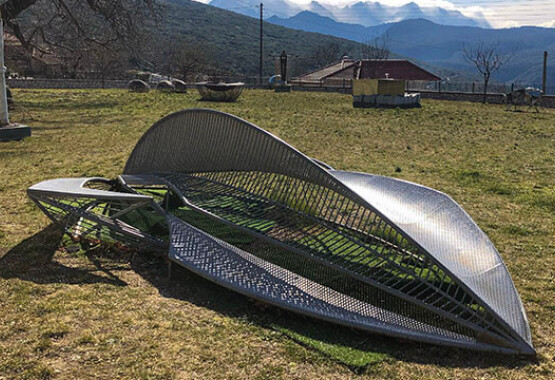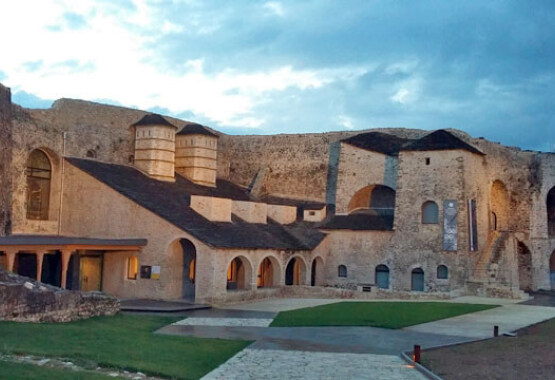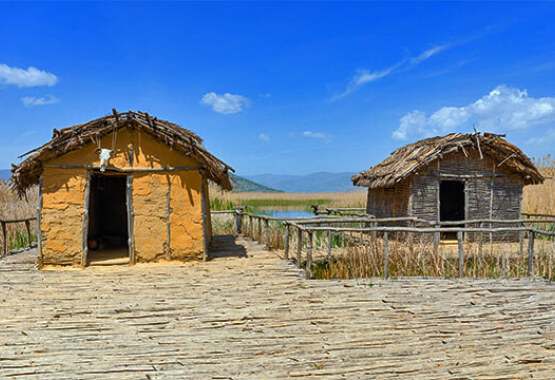
IOANNINA
Though quite downgraded from then on, especially after its first destruction in 219 BCE by the Aetolians, who under Dorimachus, burned the shrine to the ground, it was reconstructed and quite active up until the rise of Christianity in 390’s CE, when Emperor Theodosius silenced the oracle, closed the temple, as it was the case with all ‘pagan’ temples, and cut down its only one surviving oracular oak tree. It is worth mentioning that according to Apollonius Rhodius, it was from this very divine oak grove of Dodona that the oracular keel of Argo was made of, after it was given by Pallas Athena to Argus, the mythical shipbuilder; an oracular keel which would consult the Argonauts during their strenuous voyage in search for the golden fleece.
According to Herodotus (2.55-7) consulting was also given by the Peleiades, the grey- headed priestesses with allusions to peleia, one of the black doves which sat on an oak tree at Dodona and in human voice indicated the site as sacred after having flown from Thebes in Egypt. From this and other sources we also learn that at Dodona, oracular consulting was given through the interpreting of the rustling of oak-leaves, or of the cooing of doves (peleiai), of the flight of birds nesting in the oak trees, as of the murmuring of the waters from the sacred spring or of the clanking of brazen vessels which were hung on the branches of the oak-trees, reminding of modern wind chimes.
At an early time though the Greek myths of origins faded, then due to the difficulty of accessing the area as well as the absence of ‘state’ oracular consultation at Dodona, the oracle’s primacy started wearing off, giving its lead to the oracle of Delphi, whose state consultation had turned it into a religious centre of significant political and diplomatic influence.
The oracle shrine at Dodona
The oracle shrine (christirion) at Dodona was located in the northwestern part of Greece, in Epirus, south-west of Ioannina. Placed in the narrow valley east of the foothills of Mt Tomaros, 600 meters above sea level, it used to be most easily accessible from the coast of Thesprotia. It was probably the oldest and most prominent oracle in the early ancient Greek world, dated to the second millennium BCE, yet soon it became second to importance after the oracle shrine of Delphi. In the early 3rd century BCE, King Pyrrhus made Dodona the religious capital of its domain, adding a number of significant buildings around the oracle such as the temple of Dione.Though quite downgraded from then on, especially after its first destruction in 219 BCE by the Aetolians, who under Dorimachus, burned the shrine to the ground, it was reconstructed and quite active up until the rise of Christianity in 390’s CE, when Emperor Theodosius silenced the oracle, closed the temple, as it was the case with all ‘pagan’ temples, and cut down its only one surviving oracular oak tree. It is worth mentioning that according to Apollonius Rhodius, it was from this very divine oak grove of Dodona that the oracular keel of Argo was made of, after it was given by Pallas Athena to Argus, the mythical shipbuilder; an oracular keel which would consult the Argonauts during their strenuous voyage in search for the golden fleece.
Divine Origins
The oracle shrine at Dodona was initially dedicated to mother earth (Gaia), who was known as Dione there and later to the couple of Zeus and Dione; in early historic times the sanctuary was an oak tree surrounded by a sacred forest of oak trees with a spring on its foot, sacred to Zeus. Zeus in the Homeric epics was called as Pelasgian, whereas Herodotus also mentioned him as Zeus Naios (i.e. of the spring with allusions to his priestesses Naiads), indicating an explicit link to earth and fertility. Aristotle (Meteorologica) considers the site of Dodona to be the cradle of Hellenes, descendants of Hellen, known as the eponymous ancestor of the entire Hellenic race and son of Deukalion. The great philosopher also places Deukalion’s Flood in the district of Dodona and the Acheloous River, an area initially known as Graecia (with Graeci possibly meaning the worshippers of mother-earth). Accordingly, Plutarch attributes the foundation of the oracle and the worshipping of Zeus to Deukalion and Pyrrha after the Flood.Dodona in ancient sources
The Homeric epics inform us that the oracle was dedicated to Zeus, the lord of Dodona, god of the Pelasgians (i.e. the ancient inhabitants of Greece), whose priests were called Selloi or Helloi (with probable ties to Hellen). According to Homer Zeus’s priests were barefoot and used to sleep on the ground under the divine oak-tree, and so we can assume that at first there was probably only an outdoors altar in proximity to the oak trees while the temple and the surrounded buildings were constructed in later years (from the 4th century BCE and on).According to Herodotus (2.55-7) consulting was also given by the Peleiades, the grey- headed priestesses with allusions to peleia, one of the black doves which sat on an oak tree at Dodona and in human voice indicated the site as sacred after having flown from Thebes in Egypt. From this and other sources we also learn that at Dodona, oracular consulting was given through the interpreting of the rustling of oak-leaves, or of the cooing of doves (peleiai), of the flight of birds nesting in the oak trees, as of the murmuring of the waters from the sacred spring or of the clanking of brazen vessels which were hung on the branches of the oak-trees, reminding of modern wind chimes.
Offerings and fame
Offerings to the divine couple of Zeus and Dione are dated as early as in the 8th century BCE. Among them there were jewellery, weapons, statuettes and many bronze tripods. Though many religious buildings and other structures were built on the site after the 4th century BCE, the sanctuary remained outdoors, while the divine oak tree was surrounded by bronze cauldrons forming some kind of an enclosure. The bronze tripods, dedicated by the oracle’s visitors, were apparently supplied by the metalworkers of the local economy, thereby contributing the most to the economy of the region.At an early time though the Greek myths of origins faded, then due to the difficulty of accessing the area as well as the absence of ‘state’ oracular consultation at Dodona, the oracle’s primacy started wearing off, giving its lead to the oracle of Delphi, whose state consultation had turned it into a religious centre of significant political and diplomatic influence.




